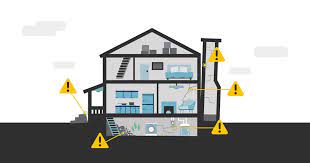A strong foundation is the foundation of a stable and secure home. However, foundations can settle over time, resulting in a variety of structural issues that must be addressed. In this blog, we will look at foundation settling, including warning signs, common causes, and solutions for homeowners who are experiencing this problem.
Foundation Settlement Signs
Recognizing the signs of foundation settling is critical for early intervention and preventing further damage. Here are some common warning signs to look out for:
1. Cracks in the Walls: The appearance of cracks in interior and exterior walls is one of the most noticeable signs. These cracks can be vertical, diagonal, or horizontal, and their width can vary.
2. Uneven Floors: If your floors are no longer level or have developed slopes or dips, this could be a sign of foundation settling.
3. Squeaky Doors and Windows: Squeaky doors and windows can indicate that the foundation has shifted, causing the frames to become misaligned.
4. Gaps in Trim or Molding: When the foundation settles, causing the structure to shift, separation between the trim and molding of your walls or ceilings can occur.
5. Cracked or Buckled Foundation: A visibly damaged or compromised foundation is an obvious sign of settling. Check for cracking, bowing, or buckling.
6. Chimney Separation: If your home has a chimney, look for signs of separation from the main structure, which can be caused by foundation movement.
7. Basement Water Infiltration: Shifting foundations can leave gaps or cracks through which water can enter your basement, causing moisture issues.
8. Sinking or Settling Exterior Concrete: If the foundation is shifting, exterior elements such as patios, driveways, and sidewalks may show signs of sinking or settling.
Common Reasons for Foundation Settlement
Understanding the underlying causes of foundation settling is critical to effectively addressing the issue. The following are some of the most common causes of foundation settling:
1. Soil Composition: The type of soil used to build your home can have a significant impact on its foundation. Expansive clay soils, for example, can shrink and swell as moisture levels change, causing foundation movement.
2. Inadequate Soil Compaction: If the soil beneath the foundation is not adequately compacted during the initial construction phase, it will settle over time.
3. Excess Moisture or Drought: Variations in moisture levels in the soil can cause expansion and contraction, affecting the foundation’s stability. Excess moisture caused by poor drainage or a long period of drought can both contribute to settling.
4. Tree Roots: If you plant large trees too close to your house, their roots can reach under the foundation and extract moisture from the soil, causing soil shrinkage and settling.
5. Poor Construction Practices: Foundation settling can be caused by poor construction practices such as inadequate footings, improperly mixed concrete, or insufficient reinforcement.
6. Geological Factors: Geological factors such as earthquakes, landslides, or soil erosion can cause foundation movement in some cases.
Foundation Settlement Solutions
To address foundation settling, a combination of investigation, repair, and prevention is required. Consider the following solutions:
1. Foundation Inspection: If you suspect foundation settling, you must hire a professional structural engineer or foundation specialist to assess the extent of the damage and identify the root causes.
2. Repair of the Foundation:
- Mudjacking: Mudjacking is a technique that involves injecting a mixture of cement, soil, and other materials beneath the settled portion of the foundation in order to lift it back into place.
- Piering or Underpinning: Installing piers or pilings beneath the foundation to provide additional support and stabilize the structure.
- Wall Anchors or Bracing: Installing wall anchors or braces in cases of foundation wall movement can help stabilize and prevent further shifting.
3. Improved Grading and Drainage: Proper grading around the home, combined with effective drainage systems, can help manage moisture levels in the soil and prevent excessive expansion and contraction.
4. Tree Root Management: If tree roots are causing foundation settling, consult with an arborist to determine the best course of action, which may include root pruning or tree removal.
5. Routine Maintenance: Implement a routine maintenance plan to address issues such as gutter maintenance, proper grading, and directing downspouts away from the foundation.
6. Preventive Measures: Consider preventive measures such as deep foundation footings, proper drainage systems, and selecting the right type of soil or soil stabilization techniques when building new or renovating your home.
7. Consult Professionals: When dealing with foundation settling issues, always consult with qualified professionals for a durable and reliable concrete foundations. DIY solutions frequently aggravate the problem or result in incomplete repairs.
The Value of Prompt Action
Addressing foundation settling as soon as you notice it is critical for avoiding future damage and costly repairs. Ignoring the problem can lead to more serious structural issues, a decrease in property value, and potentially dangerous living conditions.
Find more about us if you suspect foundation settling in your home to assess the situation and determine the best course of action. You can ensure the stability and longevity of your home’s foundation by taking timely measures, giving you peace of mind and protecting your valuable investment.

